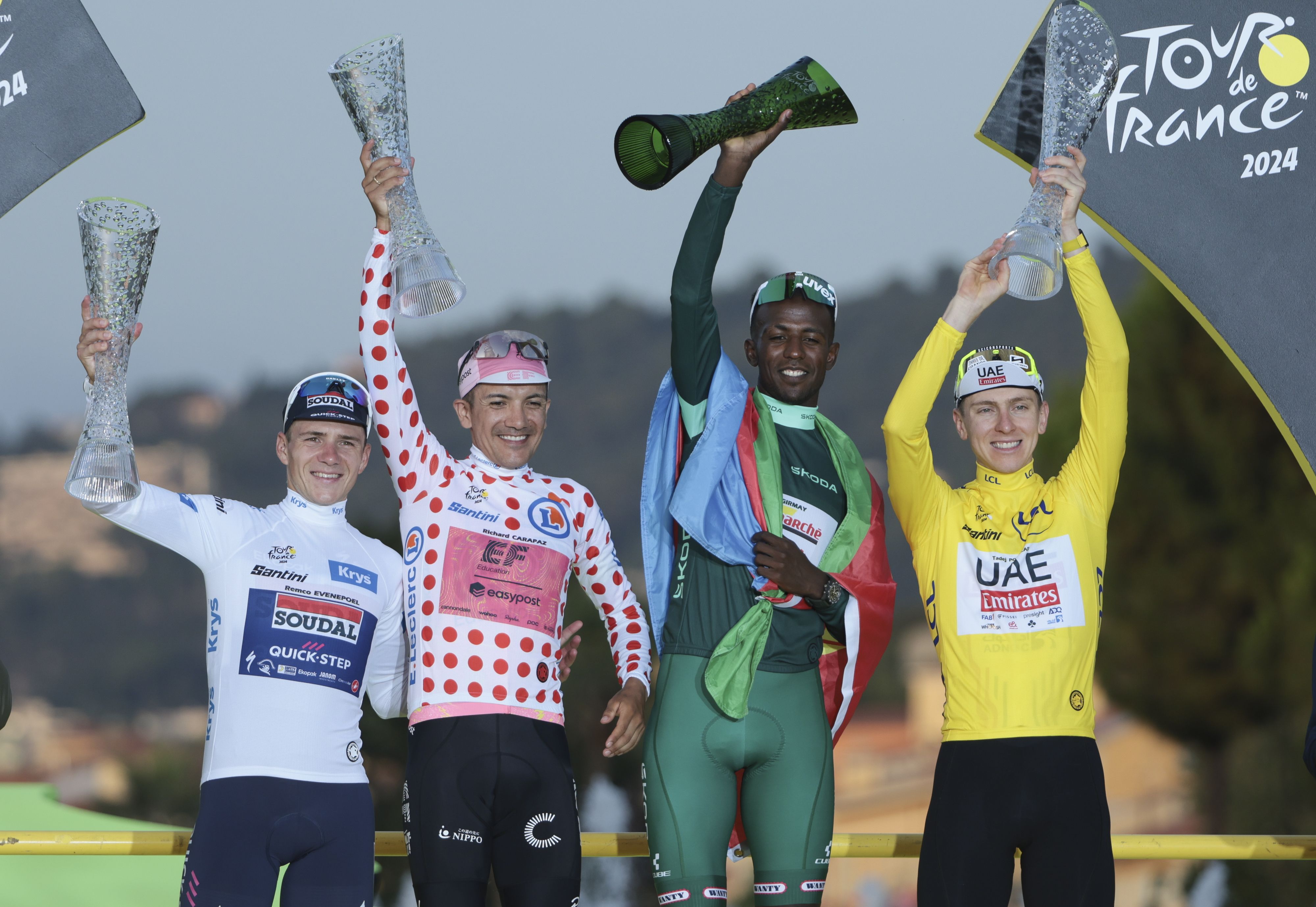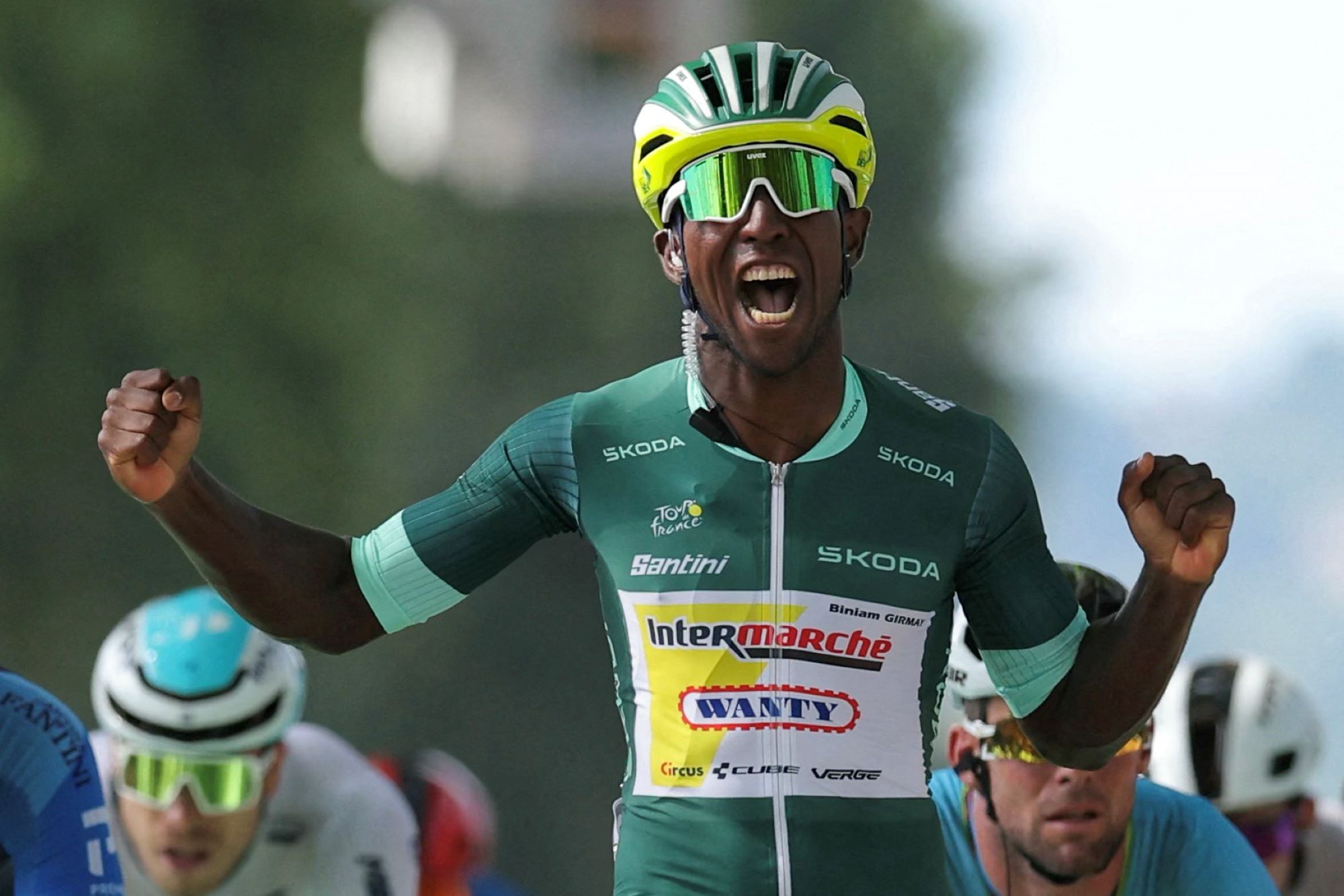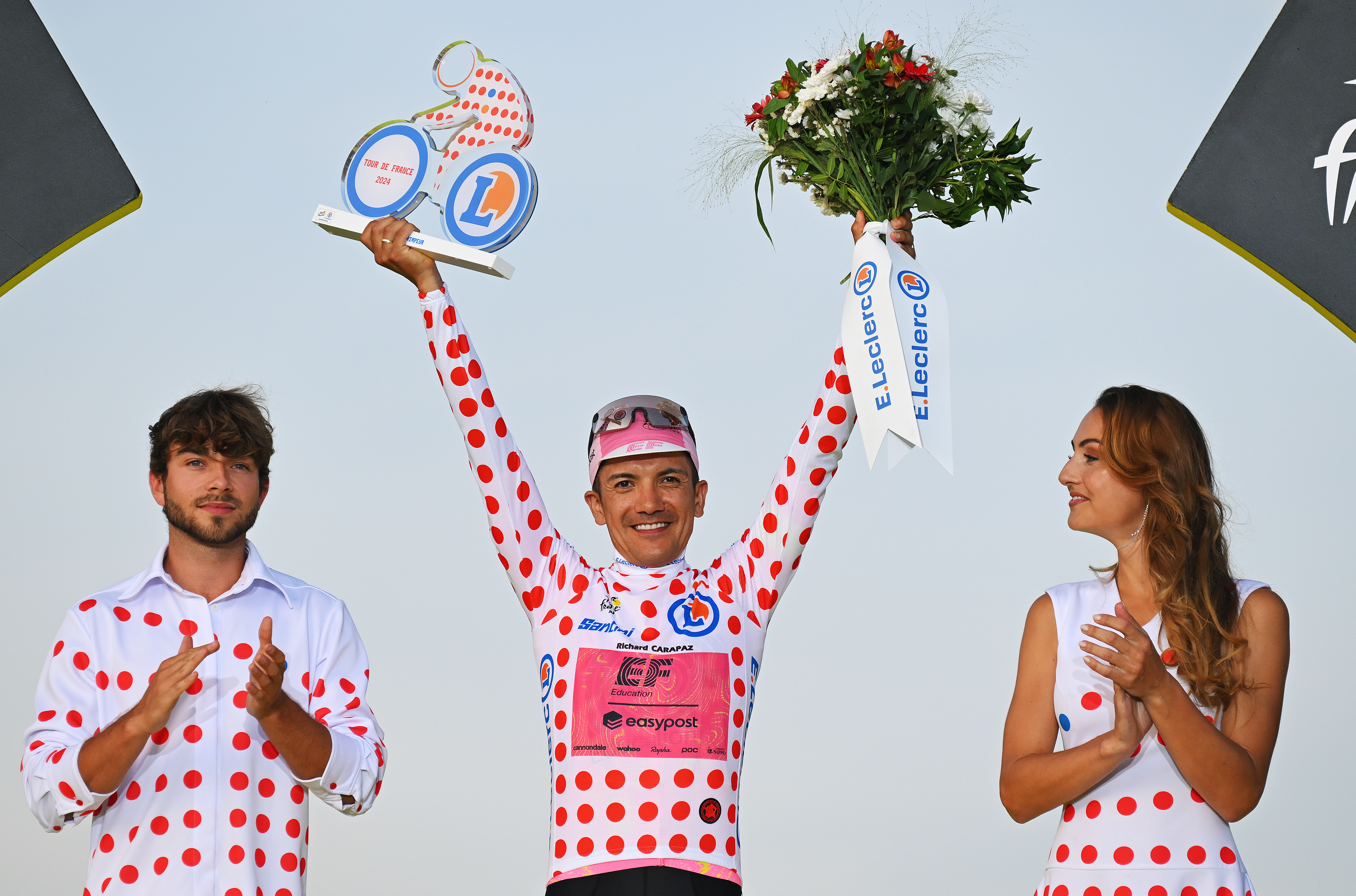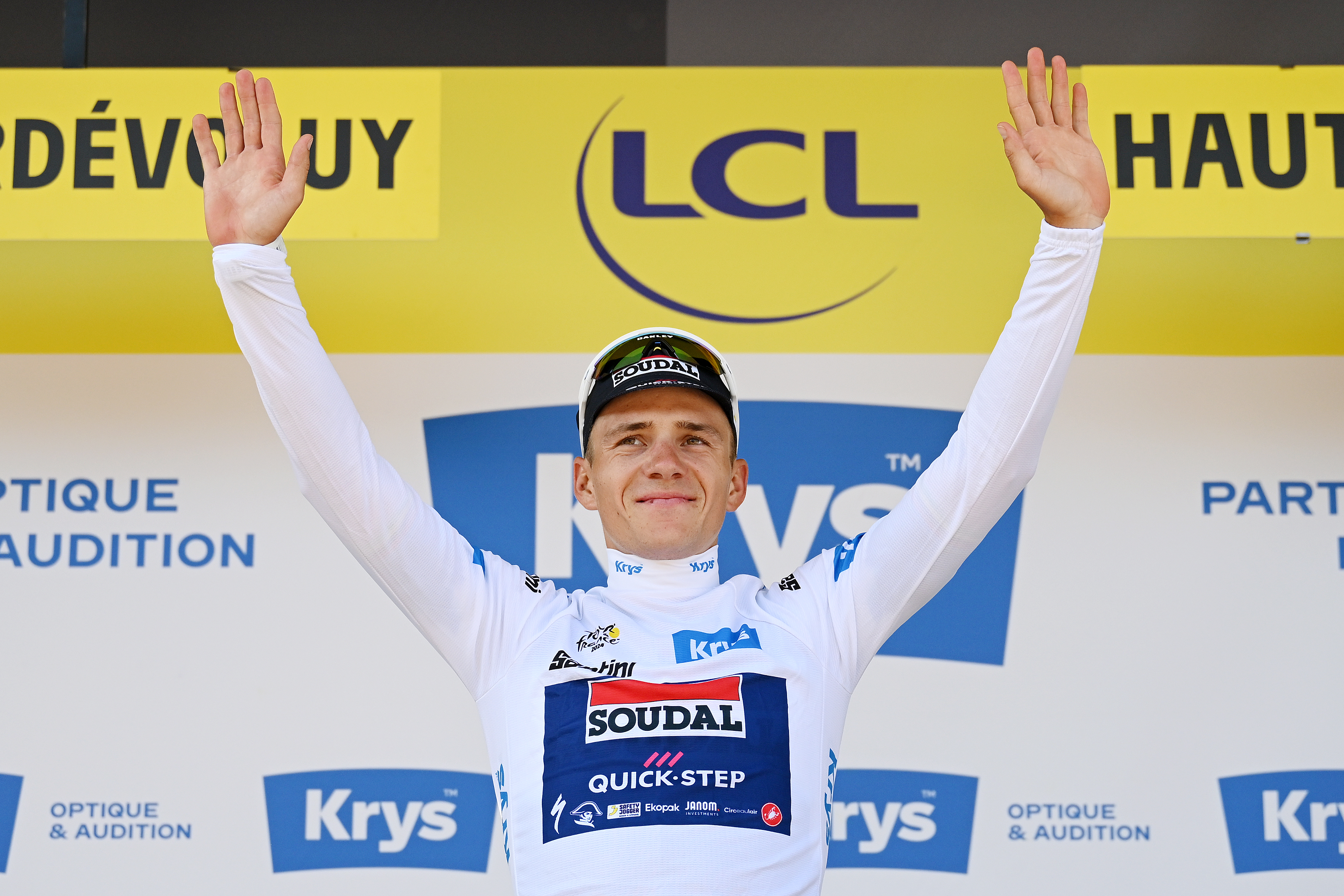Tour de France jerseys: Yellow, green, white and polka dot explained
We explain what the yellow, green, polka dot and white jerseys worn by riders in the Tour de France represent


Jersey colour | Classification |
Yellow | General classification, overall leader |
Green | Points |
Polka dots | Mountains |
White | Best young rider |
The Tour de France sees the very best cyclists in the world battle it out for the yellow, green, white and polka dot jerseys, based on the general, points, mountains and young rider classifications.
The jersey for each category is awarded to the leader of that classification at the end of every stage, and the recipient earns the right to wear it during the following day's racing. When a rider has the lead in multiple classifications, the yellow jersey is prioritised, then green, the polka dot, and white - the next person on the ranking wears the kit in the leader's stead.
Here we take a brief look at what they are and how they are won.

Tour de France yellow jersey - GC leader
Also called the maillot jaune, the Tour de France yellow jersey is the most coveted piece of kit in professional cycling. The wearer is the rider who has completed the race in the least amount of time, and as such tops the overall or general classification (GC) of the race.
Tadej Pogačar (UAE Team Emirates) dominated the GC in 2020 and 2021, wearing the yellow jersey almost throughout the 2021 edition, before Jonas Vingegaard (Jumbo-Visma) took it off him halfway through the 2022 race, wearing it until the end of the race. He went on to win it again in 2023. In 2024, Pogačar roared back, dominating again.
Before that, in 2012, Bradley Wiggins became the first British rider to finish in Paris in the Yellow Jersey - with Chris Froome following up in 2013, 2015-2017. Geraint Thomas took the 2018 race, becoming the third British rider to win the race.
The yellow jersey is sponsored by LCL, a French bank, and it is yellow, because the Tour's original organiser, L'Auto, was a newspaper printed on yellow paper.
The latest race content, interviews, features, reviews and expert buying guides, direct to your inbox!
A time bonus of 10, six and four seconds will be awarded to the first three riders across the finish line each day (not including TTs). These bonus seconds are taken off their stage and therefore overall time. Bonus seconds of eight, five and two seconds are also awarded on certain, strategically placed climbs on stages one, two, five, 12, 14 and 17.
Last 10 winners of the Tour de France general classification:
- 2015: Chris Froome
- 2016: Chris Froome
- 2017: Chris Froome
- 2018: Geraint Thomas
- 2019: Egan Bernal
- 2020: Tadej Pogačar
- 2021: Tadej Pogačar
- 2022: Jonas Vinegaard
- 2023: Jonas Vinegaard
- 2024: Tadej Pogačar
Tour de France green jersey - points classification

The green jersey relates to points awarded to riders according to the position they finish on each stage, with additional points for intermediate sprints during some stages also on offer.
The number of points on offer will vary depending upon the type of stage. More are on offer during pure flat, sprint days, while on hilly and mountain stages there are fewer points available. The points are then tallied up after each stage and added to points won in all previous stages. The green jersey (maillot vert) is awarded to the rider with the most points. Sometimes it is a sprinter's game, sometimes more of an all-rounder - like Wout van Aert (Visma-Lease a Bike).
The jersey took its colour because the initial sponsor was a lawn mower manufacturer - though the colour was changed once in 1968 to accommodate a sponsor. It is now sponsored by Škoda, and has a newer shade.
Both Eddy Merckx and Bernard Hinault successfully won both the general classification and the points classification with Merckx achieving the biggest sweep in 1969 with the points, mountain and general classifications to his name. Over the last ten years, Peter Sagan has triumphed in the points classification on no less than seven occasions.
After Sagan's period of domination, the green jersey has had a different winner for the last five seasons.
The following points are on offer:
Flat stage (stages 2, 3, 5, 6, 8, 9, 10, 12, 13, 16): 50, 30, 20 points (descending to 15th place)
Hilly stage (stages 1, 11, 17, 18): 30, 25, 22 points (descending to 15th place)
Mountain stage and ITTs (4, 7, 14, 15, 19, 20, 21): 20, 17, 15, (descending to 15th place)
Intermediate sprint: 20, 17, 15, (descending to 15th place)
Last 10 winners of the Tour de France points classification:
- 2015: Peter Sagan
- 2016: Peter Sagan
- 2017: Michael Matthews
- 2018: Peter Sagan
- 2019: Peter Sagan
- 2020: Sam Bennett
- 2021: Mark Cavendish
- 2022: Wout van Aert
- 2023: Jasper Philipsen
- 2024: Biniam Girmay
Tour de France jerseys: Polka dot - King of the Mountains classification leader
Tour de France polka dot jersey - mountains classification

Mountains points are awarded to riders who manage to summit classified climbs first. Points vary depending on the category of each ascent, with more difficult climbs awarding more mountains points.
Climbs are divided into five categories: 1 (most difficult) to 4 (least difficult) - then there's the 'Hors Categorie', denoted by HC which represents the most challenging of ascents. The tougher the category, the more points on offer, and to more riders - a HC climb will see points awarded down to the first eight over the summit, while a fourth category climb results in points for just the first rider over the top.
The organisers decide which mountains or climbs will be included in the competition, and which category they fall into. If the stage features a summit finish, the points for the climb are doubled.
The points are tallied up after each stage and added to points won in all previous stages. The distinctive white-with-red-dots jersey (maillot à pois rouges) is given to the rider with the most mountains points. The first climber's award was given out in 1933, and the jersey arrived on the scene in 1975. It is now sponsored by Leclerc, a supermarket.
Sometimes the competition is won by the overall winner, as has happened with Pogačar and Vingegaard in recent years, while sometimes it has been taken by specialists.
Points awarded as follows:
HC: 20, 15, 12, 10, 8, 6, 4, 2pts
1st cat: 10, 8, 6, 7, 5, 1pt
2nd cat: Five, three, two.
3rd cat: Two and one points
4th cat: One point
The souvenir Henri Desgrange is awarded to the first rider over the race’s highest point, the Col de la Loze, with a bonus of 40, 30, 24, 20, 16, 12, 8, 4 points, on stage 19.
Last 10 winners of the Tour de France mountains classification:
- 2015: Chris Froome
- 2016: Rafał Majka
- 2017: Warren Barguil
- 2018: Julian Alaphilippe
- 2019: Romain Bardet
- 2020: Tadej Pogačar
- 2021: Tadej Pogačar
- 2022: Jonas Vinegaard
- 2023: Giulio Ciccone
- 2024: Richard Carapaz
Tour de France white jersey - best young rider

The plain white, young rider classification jersey is awarded to the fastest rider born after 1 January 2000, meaning 25 or under. It is sponsored by Krys, an opticians
First introduced in 1975, riders such as Marco Pantani, Alberto Contador, Egan Bernal and Tadej Pogačar have all won the young rider classification, helping propel them onto bigger and better things during their careers.
Pogačar was dominant in the white jersey competition, but he is no longer eligible. Remco Evenpoel still is.
Last 10 winners of the Tour de France young rider classification:
- 2015: Nairo Quintana
- 2016: Adam Yates
- 2017: Simon Yates
- 2018: Pierre Latour
- 2019: Egan Bernal
- 2020: Tadej Pogačar
- 2021: Tadej Pogačar
- 2022: Tadej Pogačar
- 2023: Tadej Pogačar
- 2024: Remco Evenepoel
Other Tour de France classifications - team and combativity
There are two further classifications that do not earn the winner(s) a coloured jersey - the most aggressive rider award and Team Classification.
While not necessarily a classification, the Combativity Award is given to the rider who has shown the most fighting spirit during each individual stage, as chosen by the race jury. They will wear a gold race number during the following day's stage. A 'Super Combativity' award is handed out on the final stage for the most aggressive rider during the whole race.
The Team Classification is based on the collective time of the three highest-placed riders from each squad. Leaders of the team classification get to wear race numbers that are yellow with black digits, and the right to wear yellow helmets. The latter is not compulsory.

Thank you for reading 20 articles this month* Join now for unlimited access
Enjoy your first month for just £1 / $1 / €1
*Read 5 free articles per month without a subscription

Join now for unlimited access
Try first month for just £1 / $1 / €1

Adam is Cycling Weekly’s news editor – his greatest love is road racing but as long as he is cycling, he's happy. Before joining CW in 2021 he spent two years writing for Procycling. He's usually out and about on the roads of Bristol and its surrounds.
Before cycling took over his professional life, he covered ecclesiastical matters at the world’s largest Anglican newspaper and politics at Business Insider. Don't ask how that is related to riding bikes.
You must confirm your public display name before commenting
Please logout and then login again, you will then be prompted to enter your display name.